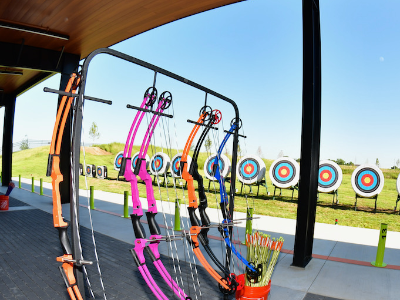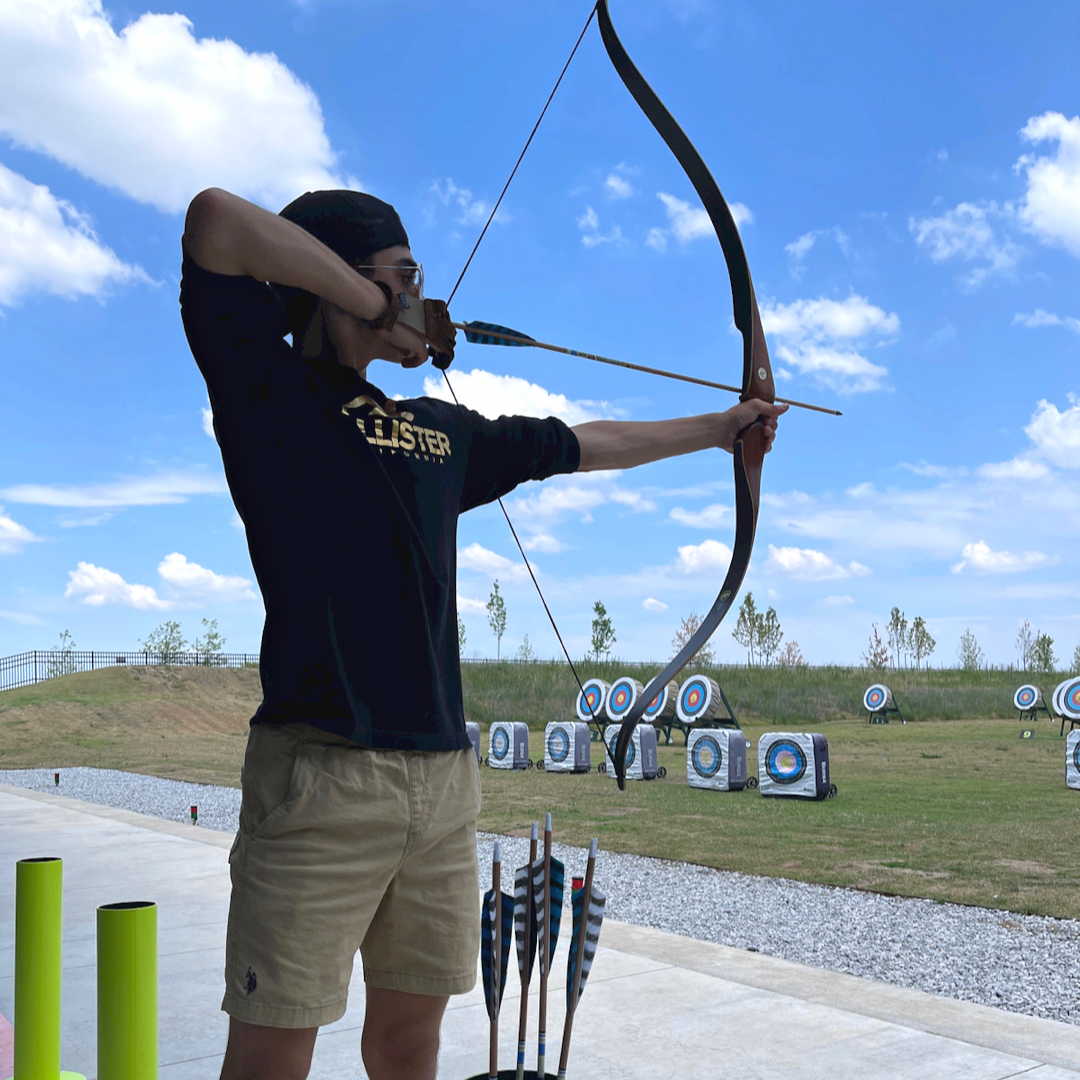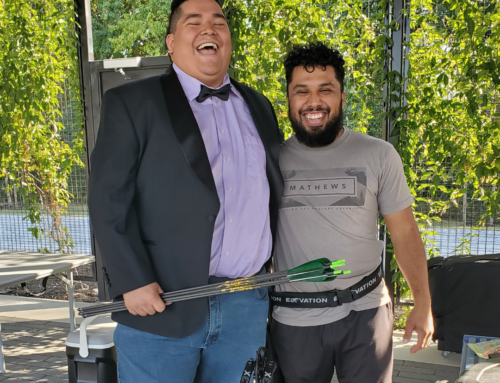
Archery Knowhow: Types of Bows
Bows with a continuous draw weight. That means that no matter how long armed (draw length) the shooter is, the amount of effort to pull the string back will stay the same through the whole draw. We use Genesis bows at the range, which fit into this category. They are often shot with similar form as a Recurve and used barebow (without any sights or aiming aids), but they can be set up with sights, stabilizers, etc to grow with an archer and be a great training bow. Genesis bows are also the exclusive bow of the National Archery in the School Program due to their ability to easily adjust to multiple users. The Genesis maxes out at 20 pounds so it’s great to learn form on. The Mini Genesis is a nice Jr version for the under 10ish kids that are starting out. Here’s the link to Genesis if you’re interested in your own, you can customize colors and options for a unique look. They also have a GenX bow which is a true compound (see below), which is the bow I currently use. https://genesisbow.com/?gclid=Cj0KCQiAuvOPBhDXARIsAKzLQ8FqJrW9_AMGXYNFkqAcO4Mll70zr2sEHTy5-tw0LOzfCyz58amWULwaAkWtEALw_wcB
Utilizing some amazing feats of engineering Compound bows have what is called a “Let off” or “breaking point.” The Cams and/or wheels (those roundish gears on the tips) flip about 2/3rds of the way through pulling back and hold somewhere between 50-80% of the draw weight for you. This allows you to be able to pull and hold a much higher poundage bow, very helpful in aiming at moving targets. Compounds also come with a draw-stop, or “back wall” that will need to be adjusted to your full draw length. This feels like you are pulling and then you hit a wall and can’t pull any further. This enables the archer to have more consistent draw length which in turn gives the archer more consistent shots. There are a ton of Compounds out there, a couple big brand names are Hoyt and Diamond. The important thing to remember when getting a compound, in my opinion, is to not over bow yourself. Over bow is when you get a bow that is just at or beyond you capability to pull. It’s best to find a bow that can adjust a wide range to start with. I like mine at a “super low” setting (mine is at 25lbs right now), so I can focus on form and shooting in a manor that won’t injure my shoulder. Yes you have a let-off, but you still have to get 2/3rds of the way drawn before that helps you. If you are shaking or tired after one set of shots, probably a good indicator you need to take the weight down. You’ll likely need to visit a bow shop to do that safely, unless you own a bow press or the bow you have is made to not need a bow press to adjust it. When in doubt, find a bow tech. The closest one to the Quiver is Jootti https://jootti.com/ There’s also a good one in Bella Vista’s Hook, Line and Sinker https://www.facebook.com/Hook-Line-Sinker-Outdoors-337690456256149/ and if you’re south, Outdoor America is a must stop http://www.outdooramericaarchery.com/ Have a favorite Bow shop I didn’t mention? Send me their info!
Recurves come in different kinds as well. You may see a traditional recurve like a horse bow which is much shorter or an Olympic style break down recurve which will be about the height of the archer. Lets talk break down recurves here. Most of these will come in 3 parts: Upper limb, Lower Limb and Riser. These may be sold all together, or with the limbs and riser separated. This is because the limbs can be exchanged to change from one poundage to another as an archer gains strength. Newer bows will have a universal connector for the limbs which snaps in and out very easily or they may have a limb bolt that can be screwed in and out with a little more effort. If the bow description doesn’t say, it probably doesn’t have the easy ones. If you have an older bow, it may have a different system as well, so be sure to check that it’s compatible if your buying new limbs. Most break down recurves will have some standard places for attachments to go. Your first one is likely to be an arrow rest which usually is not included. You may add other things as you advance such as sights, stabilizers, cushion plunger and clickers. To pick a recurve, you’ll want to know the archer’s height and get a bow close to matching that. This allows for some physics and geometry to take place with the bow and archer which allow for a better shot. It also will alleviate over pulling. If you ever pull a recurve and you reach a point it gets supper harder to pull, almost like it’s doubled or tripled the weight, you’re stacking and it’s not good for you or your bow, get a longer bow. I’d recommend talking to a specialist from Lancaster Archery Supply about a recurve: https://lancasterarchery.com/
There are many traditions that come from all over the world to make and shoot a bow and arrow. Generally speaking, a bow is traditional if it does not have sights (aiming aids) or anything else that would stick out off the bow. They are usually made from a single piece of wood (a self-bow) or maybe they are laminated (layers glued together). They can be straight long bows (English long bows) or short bows (Plains Indian bows), or they could be short recurves (Mongolian bows, Korean Gakgungs). Then there are some really unique shapes such as a Japanese Yumi. They all have different traditions on how to shoot that match their unique history and use. I can tell someone is use to shooting traditional “style” if they are bring the arrow back and anchoring closer to their eye, have a wider stance, and they may also be bending knees. These bows are often one of a kind master pieces because they are typically hand made. If they are wood, you may have to oil them regularly and take care in their storage. Never leave a traditional bow strung over long periods of time, especially ones that are straight when unstrung. It can cause them to warp and loose their draw weight. Traditional equipment is sometimes harder to find, you’d also like to see your bow and feel it before you purchase. You can visit a Renaissance festival or find some vendors from them online. There is a traditional store in Fayetteville called Dick Palmer’s, he was a well known bow maker in his youth and still keeps shop, sort of. You’ll have to give it a google since he doesn’t have a website and I suggest finding out the hours before you go. Took me 3 tries to visit on an open day/time, and bring cash. A bigger online supplier is 3 Rivers Archery, which is a great start but may leave you wanting something more personalized. https://www.3riversarchery.com/







